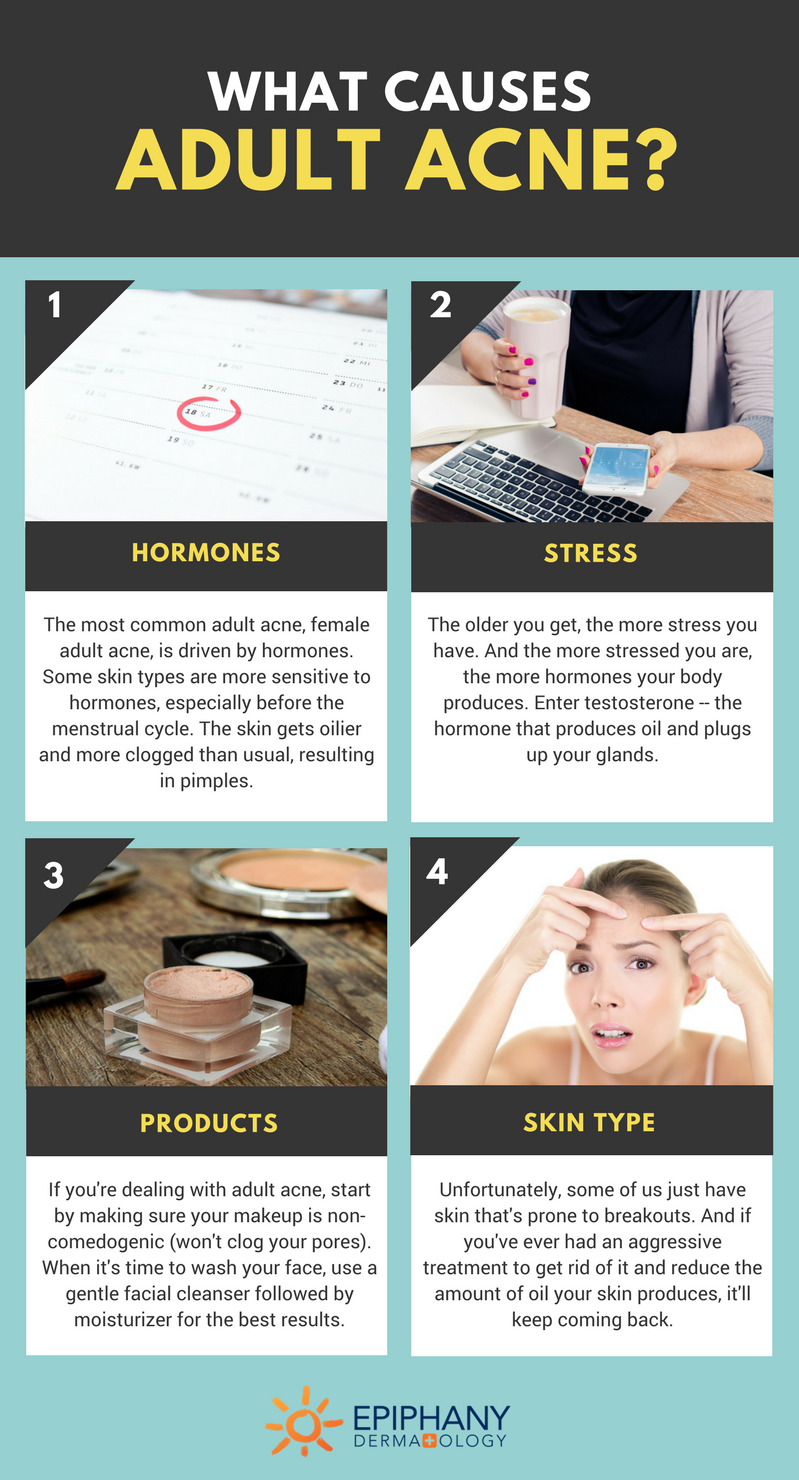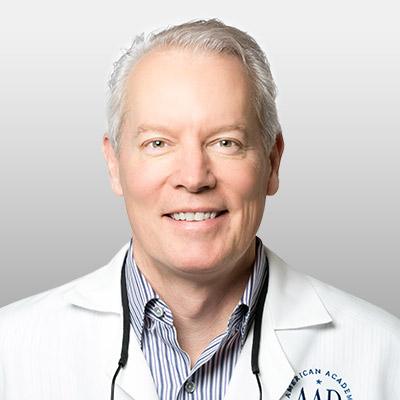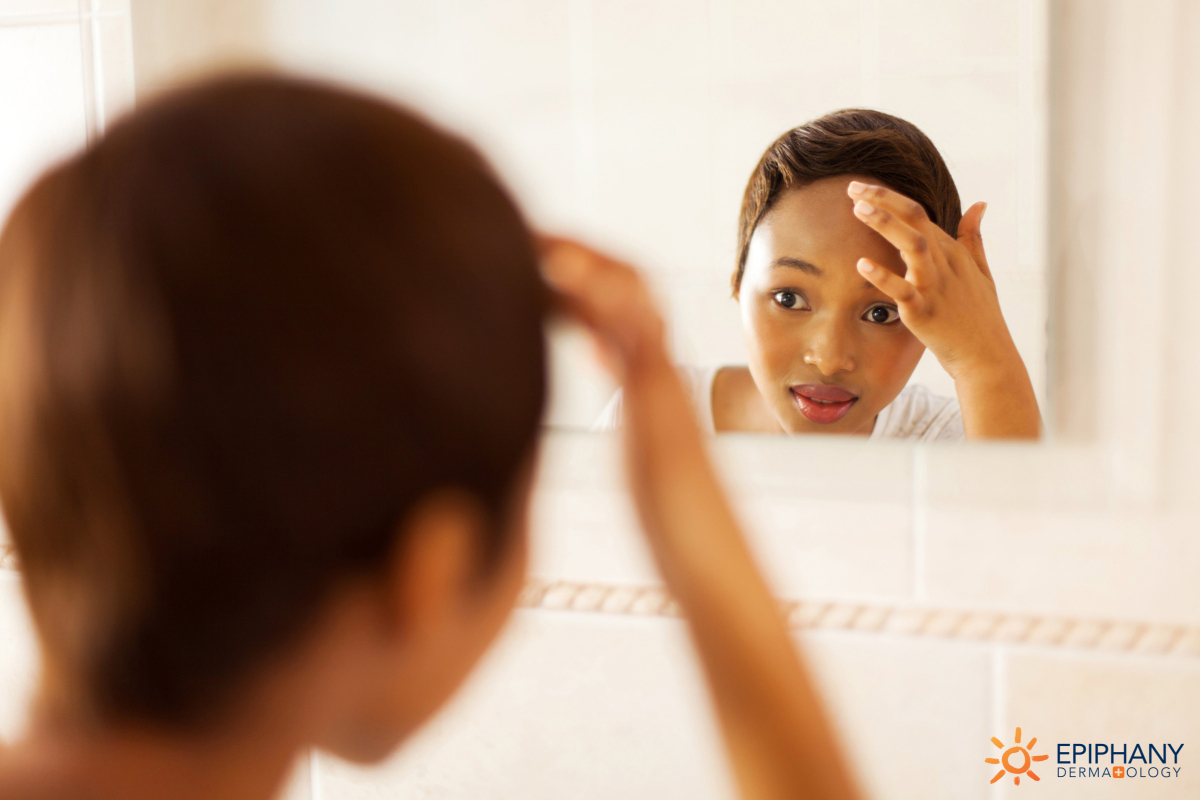Isn’t acne something only teenagers should have?
As you trudged through adolescence, you figured acne would exit as you entered adulthood. Now, it’s been a while since graduation, but those embarrassing pimples haven’t moved on. You keep thinking, “Maybe next year, I’ll age out of my acne.”
You’re not a kid anymore, so why should you have to deal with this? You shouldn’t — but you’re not the only one who is.
Many adults, particularly females, battle acne into adulthood. But, once you know what causes pimples in adults, you can find the best treatment to get the clear skin you’ve been waiting for.

Adult Acne Causes
1. Hormones
The most common adult acne, female adult acne, is driven by hormones. It’s not that there’s an abnormal level of hormones — it’s that the hormone levels are fluctuating. As the levels change, some skin types react by breaking out. Usually,
those pimples pop up because of a sensitivity to testosterone. The skin gets oilier and more clogged than usual, resulting in pimples.
So what causes this hormonal adult acne? For women, it’s the typical “girl stuff” that causes the problem. Typically, hormone levels change during menstrual cycles, pregnancy, peri-menopause, menopause, and anytime your birth control method
changes.
The best offense is a good defense. Wash your face with a gentle cleanser. You don’t want to cause more skin distress by over-washing and drying it out. Keep moisturizing and be ready with your doctor-recommended medication.
2. Stress
Other times, stress triggers adult breakouts. The older you get, the more stress you have. Balancing work, family, friends, and finances isn’t exactly easy. Your stress triggers a rise in hormones and amps up your adrenal glands — which also
stimulate oil production. That extra oil primes your skin for clogged pores and pimples.
So keep your stress under control. Take a walk, get some sleep, practice yoga. And avoid other things that stimulate your adrenal glands, like caffeine and sugar.
FREE Download: The Dermatologist’s Guide to Washing Your Face
Washing your face is the most basic step in hygiene, but are you doing it correctly? Start by following these steps to clearer, brighter skin.
Did you know? The more stressed you are, the more hormones your body produces. Enter testosterone — the hormone that produces oil and plugs up your glands.
3. Products
If you’ve battled acne for a while, chances are you’ve tried every product on the shelves. But more product isn’t always better. And even though you’re trying to get rid of the oil that plugs up your pores, dry skin isn’t the goal.
If you’re new to acne, maybe you don’t know where to begin with acne-fighting products. Start by checking the products you use. Make sure your moisturizer and makeup are non-comedogenic. That just means they won’t clog your pores. And make sure
you choose the best makeup products for oily skin.
Related Post: How to Choose the Best Makeup Products for Oily Skin
4. Skin Type
Maybe you have acne because you’ve always had acne. Some of us just have skin that’s prone to breakouts. Plus, it’s hereditary. If your parents had acne, you likely have it too. And if you’ve never had an aggressive treatment to get rid of it
and reduce the amount of oil your skin produces, it’ll keep coming back.
If genetics seem to be one of the causes of your adult acne, visit a dermatologist to start an aggressive acne treatment. These breakouts are more difficult to treat, so go straight to a professional. You’ll likely need something stronger than
an over-the-counter acne cream.
5. Medication
Some medicines trigger breakouts. If you see an increase in breakouts while taking a prescribed medication, ask the doctor who prescribed it whether acne is a potential side effect. If so, they may be able to prescribe an alternative medicine.
If there’s no alternative, continue taking your medication and visit a dermatologist who can help you control the acne.
6. Food and Drink
There’s no clear cause-effect relationship between acne and foods, but experts still have their suspicions.
People who eat food from hormone-fed animals (like milk, yogurt, cheese) have shown an increased risk of acne. So try some dairy alternatives or opt for organic
products with less influence from artificial hormones.
Also, some people notice their acne flares up with greasy or sugary foods and beverages, but there’s no clear relationship. However, if you notice a change
in your complexion with certain foods, avoid them and see if it clears up.
Maybe It’s NOT Acne
If you’ve tried to treat your acne but haven’t seen any improvement, you could be dealing with something else. Maybe you’ve even visited your doctor for acne treatment, only to be disappointed with the results. Both rosacea and folliculitis
can be confused with acne — even by professionals.
Rosacea
The most common condition confused with acne is rosacea. It has a background of redness with inflammatory papules and pustules that look very similar to acne. It pops up on the forehead, nose, cheeks, chin, and chest. We often have patients that
come in for acne treatment, but when we see them, we realize they have rosacea. Sometimes, their primary care doctor has even treated them for acne, but it hasn’t gotten better. It was just rosacea masquerading as acne.
Folliculitis
Folliculitis is a hair follicle infection. There are several types that look a lot like acne.
Ever noticed little bumps that seem to come from nowhere? Do they have a pustule on top of the hair follicle? This type of folliculitis is a type of yeast infection that happens after sweating or wearing tight clothing. The bumps pop up quickly
and get worse in the heat of the summer.
Shaving is another cause of an acne-like folliculitis. Men, if you see bumps on the back of your neck after a haircut or on the front of your neck after shaving, you’re dealing with infected hair follicles, not acne. Bacteria can enter and clog
the pores as you shave, resulting in these small, red bumps.
Adult Acne Treatment Options
No matter the cause of your acne, there are a few steps everyone should take.
- Follow a proven skincare regimen. It’s not complicated — it’s intentional.
- Don’t over-wash your face. Drying it out with only create more imbalance and erratic oil production which makes your acne worse.
- Always buy non-comedogenic skincare products (that won’t clog your pores).
Whether you’re dealing with acne at 25, 35, or 45, it’s time to see your dermatologist. At Epiphany Dermatology, we offer a wide range of acne services, including prescription medications, acne surgery,
and photofacials.
At this point, your acne (or rosacea or folliculitis) probably won’t go away on its own, but a professional can help you identify what’s causing it and find the best treatment for you.
If you’re considering acne treatment, check out these before-and-after pictures of Acne Treatment at Epiphany Dermatology.

Dr. R. Todd Plott is a board-certified dermatologist in Coppell, Keller, and Saginaw, TX. His specialization and professional interests include treating patients suffering with acne, identifying and solving complex skin conditions such as psoriasis, rosacea, atopic dermatitis, and identifying and treating all types of skin cancers. In his spare time, Dr. Plott enjoys cycling, traveling with his wife, and spending time with his children and new grandson.
Learn more about Dr. Plott.

